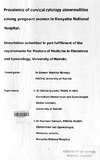| dc.contributor.author | Ndungu, Samuel W | |
| dc.date.accessioned | 2016-06-28T06:34:25Z | |
| dc.date.available | 2016-06-28T06:34:25Z | |
| dc.date.issued | 2009 | |
| dc.identifier.uri | http://hdl.handle.net/11295/96511 | |
| dc.description.abstract | Background: Cancer of the cervix is the leading cause of cancer related deaths among women in Kenya. Cervical cytology screening programs have been shown to significantly reduce mortality and morbidity associated with cancer of the cervix. Since 90% of pregnant women in Kenya attend antenatal clinic (ANC) at least once, the ANC offers an excellent opportunity for cervical cytology screening. Objective: To determine the prevalence of abnormal cervical cytology among pregnant women attending ANC at Kenyatta National Hospital (KNH).
Design: Cross-sectional descriptive study.
Setting: Kenyatta National Hospital antenatal clinic.
Study population: Pregnant women attending the first (booking) antenatal visit from February 2008 to August 2008.
Methods: A Papanicolaou (pap) smear was taken for each consenting participant during the first antenatal visit. A cervex™ brush was used to collect the cervical smears. The specimens were analyzed and reported on a standardized laboratory form. The social demographic profiles of the participants were obtained using a structured questionnaire. HIV serostatus was obtained from the participants' routine antenatal profiles.
Results: A total of 171 women attending their first ANC visit were recruited. The mean maternal age was 28.5 years with a range of 18 to 42. The mean gestation at the booking visit was 28 weeks with 57.9% of the participants initiating ANC in the 3rd trimester. Only 10.5% had had previous screening for abnormal cervical cytology. One hundred and sixty six (97.1%) pap smear specimens were satisfactory for evaluation. Five (2.9%) were unsatisfactory for evaluation. The prevalence of Squamous intra-epithelial lesions was 5.8% ( 3.5% LSIL, 2.3%
HSIL). Thirty one percent were inflammatory, 1.2% had Trichomonas vaginalis, 7% had bacterial vaginosis (diagnosed by the presence of clue cells) and 10.5% had Candida spp. Forty nine percent of the pap smears were reported normal.
HIV sero-positive status and abnormal vaginal discharge were significantly associated with the presence of any pap smear abnormality (p value <0.05).
11
Conclusion
The prevalence of abnormal cervical cytology was 5.8%.
Positive HIV sero-status and presence of abnormal vaginal discharge were noted to be associated with a higher risk of pap smear abnormalities.
The rate of previous screening for cervical cytology was low. Only 10.5% of the participants had had a pap smear done in the past.
Recommendation
Cervical cytology screening should be included in routine antenatal care in our hospitals. This would be in line with the WHO model on focused antenatal care which recommends cervical cytology screening on the first antenatal visit. Antenatal care givers should actively promote and provide counseling and testing for HIV as this was observed to increase the risk of abnormal cervical cytology. Antenatal mothers with vaginal discharge should be evaluated to rule out reproductive tract infections. | en_US |
| dc.language.iso | en | en_US |
| dc.publisher | University of Nairobi | en_US |
| dc.rights | Attribution-NonCommercial-NoDerivs 3.0 United States | * |
| dc.rights.uri | http://creativecommons.org/licenses/by-nc-nd/3.0/us/ | * |
| dc.subject | cervical cytology abnormalities, pregnant women, K N H | en_US |
| dc.title | Prevalence of cervical cytology abnormalities among pregnant women in Kenyatta National Hospital. | en_US |
| dc.type | Thesis | en_US |
| dc.description.department | a
Department of Psychiatry, University of Nairobi, ; bDepartment of Mental Health, School of Medicine,
Moi University, Eldoret, Kenya | |



